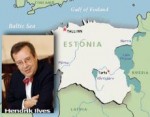Estonian leader discusses independence, change

Estonian President Toomas Hendrik Ilves spoke at USF on Monday afternoon about Estonia’s advancement after gaining independence and its technological advancements.
“One of the few things I’ve learned is that the last thing you want to do is give other countries advice,” Ilves told a crowd of about 75 in Ferguson Hall.
President Ilves spoke about the Baltic nation’s role in international business and the rapid economic growth the country has achieved since it broke away from the former Soviet Union in 1991.
“It took us 50 years to get free. That was not a easy task,” Ilves said.
He described the difficulties Estonia faced after independence was restored. He said the infrastructure at the time consisted of what was left over from Soviet occupation, most of which was built in the 1930s. At the time, the per-capita gross domestic product (GDP) – the portion of national income per citizen – was $702 a year.
“It was not simple, it was not easy and it was not something everyone thought we could do,” he said. “In fact, even the United States often gave us advice on what we should not do or what we should do, which we chose to disregard.”
Ilves attributed Estonia’s rapid economic growth – a per-capita GDP increase of $12,600 over 15 years – to its early computerization policies.
“Today, Estonia is one of the most interneted countries in the world,” he said. “We have e-government, where people can vote online if they want.”
Ilves said that Estonia was aggressive in advocating computer literacy.
“We went after that with a vengeance,” he said. “We introduced computerization at all levels of society.”
He also said that the computerization attributed to the accountability of the government.
“We saw that society could be less corrupt by having everything open and online instead of based on paper,” he said.
Popular computer programs Kazaa and Skype were invented by Estonians, he said.
“That kind of atmosphere led to Estonians to many creative things,” Ilves said.
Ilves said that Estonia adopted the policy of encouraging technology growth early after its independence because it is a country with a little over 1 million people. A country as small as Estonia needs to increase its productivity beyond what its population base could normally achieve, he said.
Estonia also has an electronic identification system that allows Estonians to set up a business in less than 20 minutes, or complete their taxes in less than five minutes. Using this, citizens can sign contracts by swiping an identification card in a computer.
The Estonian president also joked about the depression of the U.S. dollar, the rising gas prices and tourism.
The key to developing a relationship between Estonia and southern Florida is “market tourism,” Ilves said.
USF Provost Ralph Wilcox said that he was proud to have Ilves speak at the University.
“Estonia is an old country with a prime tradition,” Wilcox said.
He also said that Florida could learn a few things from the Estonians.
“I think Florida, perhaps, could learn something about effective voting,” Wilcox said, commenting on Estonia’s online voting system.





